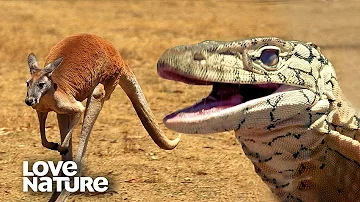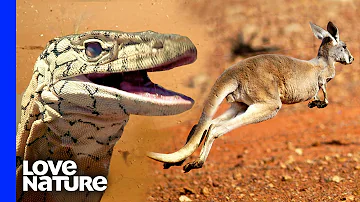
Perentie
Varanus giganteus

Meet the Perentie
The perentie is Australia's largest monitor lizard and one of the largest lizards in the world, reaching lengths up to 2.5 meters (8.2 feet). It has a robust, streamlined body with a long neck, powerful limbs, and a pointed snout, adorned with striking cream and brown patterns that provide excellent camouflage in its arid environment. Known for their impressive speed and agility, perenties are formidable predators that primarily hunt on the ground but are also skilled climbers. Their diet consists mainly of small mammals, birds, reptiles, and carrion, making them top predators within their range. The perentie is shy and elusive, often avoiding human contact and inhabiting remote, sparsely populated regions of Australia.
Classification
Reptile
Habitat
Arid desert and rocky outcrops
Diet
Carnivore
Lifespan
15-20 years
Conservation
Least Concern
Weight
15-20 kg
📖Fascinating Facts
Australia's Largest Lizard
The perentie is the largest monitor lizard native to Australia and the fourth largest lizard in the world.
Desert Specialist
Perenties are specially adapted to survive in arid environments, often found in rocky outcrops and sandy deserts where water is scarce.
Fast Runners
With powerful legs, perenties can sprint at impressive speeds and even temporarily run bipedally to escape danger.
📋Detailed Description
The perentie (Varanus giganteus) is the largest monitor lizard native to Australia and the fourth largest lizard globally, with adults commonly reaching total lengths of 1.5–2.0 meters and exceptional individuals exceeding 2.5 meters. Its robust, streamlined body is covered in small, granular scales, and it displays a striking pattern of cream or yellowish spots and reticulations on a brown to tan background, providing effective camouflage against arid rocky landscapes. The head is elongated with a pointed snout, equipped with sharp, recurved teeth and a long, deeply forked tongue used for chemosensory detection. Limbs are muscular and end in strong, curved claws adapted for digging and climbing. The tail is laterally compressed and muscular, aiding in balance and defense. Perenties are highly agile and capable of rapid bursts of speed, both on land and when climbing. They possess acute vision and olfactory senses, which are crucial for detecting prey and avoiding predators. The species is primarily terrestrial but will ascend trees or rocky outcrops when threatened or searching for food. Perenties are solitary and territorial, with individuals occupying large home ranges that can exceed several square kilometers. Their secretive nature and preference for remote, arid habitats make them infrequently observed in the wild.
💡 Did you know?
The perentie is capable of delivering a powerful, venomous bite, as recent studies have shown that all monitor lizards possess venom glands.
🔬Research & Sources
Wikipedia Summary
The perentie is a species of monitor lizard. It is one of the largest living lizards on earth, after the Komodo dragon, Asian water monitor, and the crocodile monitor. Found west of the Great Dividing Range in the arid areas of Australia, it is rarely seen because of its shyness and the remoteness of much of its range from human habitation. The species is considered to be a least-concern species according to the International Union for Conservation of Nature.
Last Modified: 5/26/2025
🎭Behavior & Social Structure
Perenties are diurnal and primarily active during the cooler parts of the day, such as early morning and late afternoon, to avoid extreme desert heat. They are solitary hunters, relying on stealth and bursts of speed to ambush prey, which includes small mammals (such as rodents and rabbits), birds, other reptiles (including smaller monitors), insects, and carrion. Large individuals have been observed preying on wallabies and even consuming other perenties. Hunting is facilitated by their acute sense of smell, using their forked tongue to sample scent particles and locate food or mates. When threatened, perenties may hiss, inflate their bodies, lash with their tails, or stand upright on their hind legs in a defensive posture, sometimes making short charges. They are known to dig extensive burrows for shelter and thermoregulation, and may also utilize rock crevices. Social interactions are limited outside of the breeding season, but males may engage in ritualized combat, wrestling and grappling to establish dominance and access to females.
👶Reproduction & Life Cycle
Perentie breeding typically occurs in the austral spring and early summer (September to December), coinciding with increased food availability. Males compete for access to females, often engaging in physical combat. After mating, females lay clutches of 6–12 leathery eggs in deep burrows or termite mounds, which provide stable temperature and humidity for incubation. Incubation lasts approximately 90–120 days, depending on environmental conditions. Hatchlings emerge fully independent and measure around 30–40 cm in length. There is no parental care post-oviposition; juveniles are vulnerable to predation and rely on cryptic coloration and rapid escape behaviors. Sexual maturity is reached at around 5–6 years of age, with growth rates influenced by food availability and environmental conditions.
🛡️Adaptations & Survival
Perenties exhibit a suite of adaptations for survival in arid and semi-arid environments. Their cryptic coloration provides camouflage among rocks and sand, while their powerful limbs and claws enable efficient digging for shelter and prey. The laterally compressed tail aids in both swimming (when necessary) and as a defensive weapon. They possess a highly efficient renal system, minimizing water loss, and are capable of tolerating high body temperatures. The forked tongue and well-developed Jacobson's organ allow for precise chemical detection of prey, mates, and predators. Behavioral adaptations include burrow use for thermoregulation and avoidance of extreme heat, as well as seasonal activity patterns aligned with environmental conditions. Their robust immune system and resistance to toxins (including venom from some prey species) are also notable evolutionary specializations.
📚Research Sources
🎨Cultural Significance
Perenties hold significant cultural value for several Indigenous Australian groups, featuring in Dreamtime stories and traditional lore as powerful ancestral beings. They are sometimes depicted in Aboriginal art and are regarded as totems by certain communities. Historically, perenties were hunted for their meat and skins, and their fat was used in traditional medicine. The species is respected for its size and strength, and sightings are often considered auspicious. In modern times, the perentie is recognized as an iconic species of Australia's arid interior and is occasionally featured in ecotourism and educational programs.
🔬Recent Research & Discoveries
Recent research has focused on the perentie's ecological role as an apex predator in arid ecosystems, its physiological adaptations to extreme environments, and its phylogenetic relationships within the Varanidae family. Studies have revealed that perenties possess mild oral venom, similar to other monitor lizards, which may aid in subduing prey and initiating digestion. Ongoing telemetry studies are providing new insights into their movement patterns, home range sizes, and habitat preferences. Genetic analyses are refining our understanding of population structure and connectivity across their vast range. Conservation research is increasingly concerned with the impacts of climate change and habitat fragmentation on perentie populations.
🎥Wildlife Videos

The Perentie
This is a video of the perentie from the BBC's Life in Cold Blood documentary series.
globalzoo

Monster Lizard: Perentie Chases After Kangaroo in Epic Hunt | Love Nature
Perentie monitor lizard's prey includes young kangaroos, other small marsupials, snakes, bats, and rodents. Behind the facade of ...
Love Nature

Australia’s Remarkable Reptiles - Lizards of Oz | Full Documentary
Australia is the driest inhabited continent on the planet with much of the inland being a virtual desert. However, cold blooded ...
Free High-Quality Documentaries

Wildlife - Just Reptiles | Free Documentary Nature
Wildlife - Episode 3: Just Reptiles | Wildlife Documentary Watch 'Wildlife - Episode 4' here: https://youtu.be/SNRyvGzDsww ...
Free Documentary - Nature

World’s Deadliest Predators: Perentie Monitor Lizard, Jaguar, Cheetah
One dominates the arid desert. One rules the dense forest. And one governs the African plain. These three deadly apex predators ...
Love Nature

The MOST VENOMOUS snakes on the planet FLEE from him! Perentie – The Dictator of the scaly world!
Meet Australia's most dangerous predator - the giant Perentie monitor lizard! In this video, you'll see how this two-meter monster ...
WildWorld
🌍Habitat Information
The Perentie typically inhabits Arid desert and rocky outcrops environments. Perenties have adapted to their environments with specialized features and behaviors.
Primary Habitat:
Arid desert and rocky outcrops
More detailed habitat information will be available soon.
🛡️Conservation Status
The Perentie is currently classified as Least Concern. Conservation efforts are crucial for preserving this species for future generations.
Common Threats:
- 🏠Habitat loss and fragmentation
- 🌡️Climate change impacts
- 🎯Hunting and poaching
- 🏭Human-wildlife conflict
⚠️Threats & Conservation Challenges
Although currently classified as Least Concern by the IUCN, perenties face localized threats from habitat degradation due to land clearing, mining, and altered fire regimes. Invasive species such as feral cats and foxes may prey on eggs and juveniles, while competition with introduced herbivores can impact prey availability. Perenties are occasionally persecuted by humans due to misconceptions or fear, although this is rare due to their remote distribution. Climate change poses a potential long-term threat through altered rainfall patterns and increased frequency of extreme temperatures, which may affect reproductive success and prey abundance. Overall, populations are considered stable, but continued monitoring is recommended, especially in areas of increased human activity.
🔬Scientific Classification
Scientific Name
Varanus giganteus
Classification Hierarchy
🔍 About Taxonomic Classification
Taxonomic classification is a hierarchical system used by scientists to classify and organize living organisms based on shared characteristics and evolutionary relationships.
The system moves from broad categories (Kingdom) to increasingly specific ones, with each animal's scientific name typically consisting of its Genus and species.
📝Community Notes
Share your observations and insights about the Perentie with our community of wildlife enthusiasts.
Join Our Community
Sign in to share your observations and connect with fellow wildlife enthusiasts.
Sign In to ContributeNo community notes yet
Be the first to share your observations about the Perentie!
Explore Perentie
Select a tab above to learn more about this amazing animal.
📸Photo Gallery
No photos available for this animal yet.
🌟Discover More Wildlife
Continue your journey of discovery with more fascinating animals from our database
